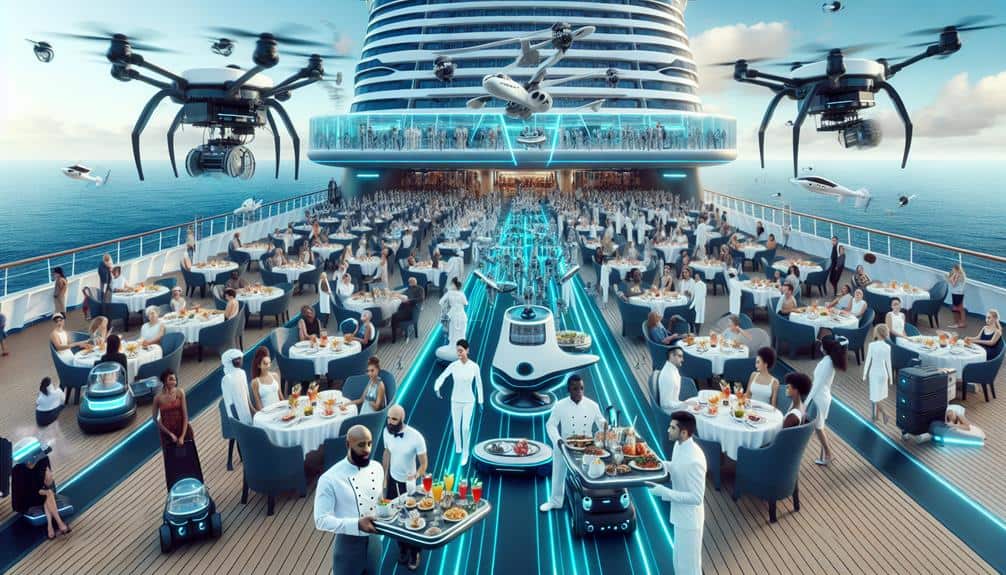When cruising, strict health screening is in place. Infrared thermometers check temperatures. Those with high temperatures are isolated. Contact tracing helps identify risks. Sanitation is a top priority. Surfaces are disinfected routinely. Crew is trained on hygiene. Social distancing rules are enforced. Spaces are rearranged for safety. Monitoring systems aid compliance. Crew undergoes rigorous training. Certifications are strictly followed. Drills are regular for emergencies. Evacuation procedures are rehearsed. Response readiness is emphasized. These steps guarantee a safe journey. More insights await on cruise ship safety measures.
Key Points
- Health screening protocols: include temperature checks and contact tracing for rapid identification of ill individuals.
- Enhanced sanitation procedures: regular disinfection of high-touch surfaces and crew training on hygiene standards.
- Social distancing guidelines: rearrange seating, limit individuals in common spaces, and educate on safe practices.
- Crew training and certification: adhere to international standards, conduct ongoing training, and simulate emergency drills.
- Emergency response preparedness: conduct evacuation drills, enhance crew communication, and ensure efficient action in high-stress situations.
Health Screening Protocols
When boarding a cruise ship, passengers are required to undergo strict health screening protocols to ensure the safety and well-being of everyone on board. These protocols typically include temperature checks using infrared thermometers to identify individuals with elevated temperatures, which could be a sign of illness. Contact tracing is also an essential part of the screening process, where passengers are asked to provide detailed information about their recent travel history and potential exposure to infectious diseases.
Temperature checks are vital as they help to quickly identify individuals who may be experiencing fever, a common symptom of various illnesses, including contagious ones. By conducting these checks at the beginning of the cruise, the ship's medical staff can promptly isolate and provide medical attention to anyone showing signs of illness, thereby preventing the potential spread of diseases among passengers and crew members.
Contact tracing complements temperature checks by allowing health authorities to track and monitor individuals who may have come into contact with an infected person. This process helps in identifying and containing the spread of illnesses on board, ensuring a safer and healthier environment for everyone during the cruise.
Enhanced Sanitation Procedures
Implementing stringent sanitation procedures on cruise ships is paramount to guaranteeing the health and safety of passengers and crew members alike. Enhanced sanitation procedures involve a combination of disinfection techniques, hygiene standards, cleaning protocols, and sanitation practices to uphold a clean and healthy environment onboard.
Disinfection techniques play a vital role in preventing the spread of germs and viruses. High-touch surfaces such as handrails, elevator buttons, and door handles are regularly sanitized using hospital-grade disinfectants. Additionally, cabins are thoroughly cleaned and disinfected between sailings to eliminate any potential contaminants.
Hygiene standards are strictly enforced throughout the ship. Hand sanitizing stations are readily available in high-traffic areas, and passengers are encouraged to practice frequent handwashing. Crew members receive training on proper sanitation practices to ensure compliance with industry regulations and guidelines.
Cleaning protocols are meticulously followed to uphold cleanliness standards. Public areas, dining facilities, and recreational spaces are regularly cleaned and disinfected. By prioritizing enhanced sanitation procedures, cruise ships can provide a safe and healthy environment for all onboard.
Social Distancing Guidelines
How can social distancing guidelines be effectively enforced on cruise ships to guarantee the safety of passengers and crew members? Ensuring passenger compliance with social distancing measures is essential for maintaining a safe environment onboard. Clear communication of these guidelines through announcements, signage, and crew instructions is vital. Passengers should be educated on the importance of maintaining a safe distance from others and the potential consequences of non-compliance.
Distancing enforcement can be facilitated by rearranging seating areas, limiting the number of individuals in common spaces, and implementing reservation systems for onboard activities to control crowd sizes. Monitoring systems, such as security cameras and designated staff members, can help make sure that distancing protocols are being followed. Additionally, the use of technology, like contactless payment systems and digital apps for reservations, can reduce physical interactions between passengers and crew.
Crew Training and Certification
To guarantee the safety and well-being of all individuals on board, crew training and certification play a pivotal role in maintaining high standards of competence and readiness in handling emergencies and providing exceptional service. Certification standards and training programs for cruise ship crew members are meticulously designed to make certain that each staff member possesses the necessary skills and knowledge to address various situations effectively.
- Certification Standards: Cruise lines adhere to strict international certification standards to ascertain that crew members have the required qualifications in areas such as first aid, firefighting, and crowd management.
- Ongoing Training Programs: Continuous training programs are conducted to keep crew members updated on the latest safety protocols, emergency procedures, and customer service practices.
- Simulated Drills: Regularly scheduled simulated drills allow crew members to practice their response to different emergency scenarios, enhancing their preparedness.
- Specialized Training: Crew members undergo specialized training based on their roles, such as medical training for medical staff and navigation training for deck officers.
- Language Proficiency: Crew members are often required to demonstrate proficiency in English or other relevant languages to ensure effective communication with passengers and colleagues.
Emergency Response Preparedness
Ensuring crew members are well-prepared for emergency response situations is paramount to the overall safety and security aboard a cruise ship. Evacuation drills play an important role in readying the crew for potential emergencies. These drills simulate various scenarios, ensuring that each crew member knows their assigned duties and the necessary procedures to follow in the event of an emergency.
Additionally, communication strategies are key in coordinating responses during crises. Crew members must be proficient in using communication devices and protocols to relay essential information swiftly and accurately.
Incorporating regular drills and training sessions enhances the crew's ability to respond effectively to emergencies, mitigating risks and ensuring the safety of all passengers and crew on board. By practicing evacuation procedures and refining communication strategies, the crew can act promptly and efficiently in high-stress situations. This level of preparedness is essential for maintaining a secure environment and instilling confidence in both passengers and crew members alike.
Frequently Asked Questions
Are Passengers Required to Wear Masks at All Times While on Board the Cruise Ship?
You must wear masks at all times on board the cruise ship, with limited exemptions. Dining areas may have specific restrictions. Follow guidelines to guarantee the safety of all passengers and staff during your cruise experience.
How Often Are High-Touch Surfaces in Public Areas Sanitized Throughout the Day?
Maintain high-touch surfaces in public areas on the cruise ship are regularly sanitized throughout the day to minimize transmission risks. Cleaning protocols should be stringent and uniform to uphold a safe environment for all passengers.
Will There Be Limitations on the Number of Passengers Allowed in Certain Areas to Ensure Social Distancing?
To guarantee social distancing, cruise ships may impose limitations on the number of passengers in specific areas. These measures align with passenger requirements and support sanitization efforts for high-touch surfaces, contributing to a safer onboard environment.
How Often Are Crew Members Tested for COVID-19 and What Happens if a Crew Member Tests Positive?
Crew members undergo regular COVID-19 testing every two weeks, with immediate isolation if positive. Rigorous contact tracing is implemented to identify potential exposures. Positive cases trigger strict quarantine protocols to prevent further spread and guarantee crew and passenger safety.
What Measures Are in Place to Handle Medical Emergencies That May Arise During the Cruise?
In handling emergencies on a cruise, a well-equipped medical response team is crucial. Trained professionals, medical facilities, and emergency protocols guarantee quick and efficient care. Regular drills and continuous staff training further enhance preparedness.




